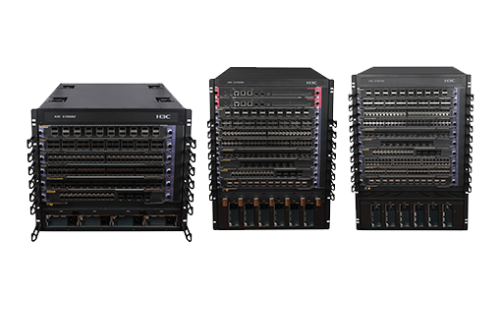
The H3C S10500 switch series is designed for the data center cloud networks, next-generation enterprise core networks, and MAN convergence. It uses H3C's proprietary operating system Comware V5 and V7 and provides the following features:
CLOS-based architecture that support 40 GE and 100 GE standards
TRILL, MDC (Multitenant Devices Context), EVI (Ethernet Virtualization Interconnect), VXLAN, EVB and FCOE
IRF2 (Intelligent Resilient Framework version 2) & IRF3 (Intelligent Resilient Framework version 3)
Convergence of MPLS, VPN, and IPv6.
The above features can maximize your network ROI and reduce your TCO.
The S10500 switch series includes S10504, S10506, S10508, S10508-V, S10510, and S10512 models, meeting the need of different port density and performance requirements.
Adopt CLOS multi-grade multi-plane architecture, providing industry leading port density
Supports high-density 40GE and 100GE interfaces and can meet the existing and future application requirements of data centers.
Adopts independent switching fabric modules and MPU engines to improve device availability and ensure bandwidth expansion.
Independent control, detection, and maintenance engines provide powerful control capability and millisecond-level HA.
Independent control engine - Uses a powerful CPU system that can efficiently process protocol and control packets, providing refined control for protocol packets and comprehensive protection against protocol packet attacks.
Independent detection engine - Provides highly reliable Fast Fault Detection and Restoration (FFDR) such as BFD and OAM, which can interact with protocols on the control plane to implement millisecond-level failover and convergence, ensuring service continuity.
Independent maintenance engine - a CPU system that provides smart power management, including sequential power-on and power-off and device status check. Sequential power-on and power-off reduces power impulse, electromagnetic radiation, power consumption, and extends the device lifespan.
IRF2 can virtualize up to four S10500 switches into one logical IRF fabric. IRF2 delivers the following benefits:
High Availability (HA) - Patented hot standby technology to provide data backup and non-stop forwarding on the control plane and data plane. This improves availability and performance, eliminates single-point failures, and ensures service continuity.
Distribution - Multi-chassis link aggregation to enable load sharing and backup over multiple uplinks, improving redundancy and link utilization.
Easy Management - A single IP address to manage the whole IRF fabric, which simplifies device and topology management, improving operating efficiency, and lowering network maintenance cost.
IRF3 virtualizes core and access switches into one logical device.
IRF3 delivers the following benefits:
Increased I/O ports and centralized maintenance and management.
Reduced network management nodes.
Simplified cable deployment.
Data plane virtualization.
MDC virtualizes one S10500 switch into multiple logical switches, enabling multiple services to share one core switch.
The 1:N virtualization maximizes switch utilization, reduces network TCO, and ensures isolation of services.
TRILL/SPB—Designed for building large flat Layer 2 networks for data centers to accommodate more servers. TRILL or SPB integrates the simplicity and flexibility of Layer 2 with the stability, scalability, and high performance of Layer 3.
EVI—EVI is a MAC-in-IP technology that provides Layer 2 connectivity between distant Layer 2 network sites across an IP routed network. It is used for connecting geographically dispersed sites of a virtualized large-scale data center that requires Layer 2 adjacency.
FCOE—Integrates heterogeneous LANs and storage networks in data centers. FCOE and CEE integrate data, computing, and storage networks in data centers, reducing the costs for building and expanding data centers.
VXLAN—Uses MAC-in-UDP encapsulation method and tunnels Layer 2 network over Layer 3 network. It provides higher
scalability of Layer 2 segmentation to 16 million and better utilization of available network paths.
OAA provides an open service platform that supports multiple service cards, including firewall, IPS, Netstream, and AC cards. The integration of these cards to the switch allows for unified network security solutions.
S10500 supports hardware level RPR 2.0 (Resilient Packet Ring version 2) technology combines SDH self-healing high reliability technology and Ethernet based advantages-economy, high bandwidth, flexibility and scalability to optimize ring topology based data management bandwidth and high-performance multi-service transport solution that enables hardware and milliseconds level ultra fast convergence and reliability assurance. Compared with RPR 1.0, RPR2.0 can integrate IRF2 / MDC and other virtualization capabilities, and support for load balancing double 20G ring topology.
S10500 switch series supports hardware level encryption technology MACsec (802.1ae), which is an industry-standard security technology that provides secure communication for all traffic on Ethernet links. Compared with traditional application based software encryption technology, MACsec provides point-to-point security on Ethernet links between directly connected nodes and is capable of identifying and preventing most security threats.
